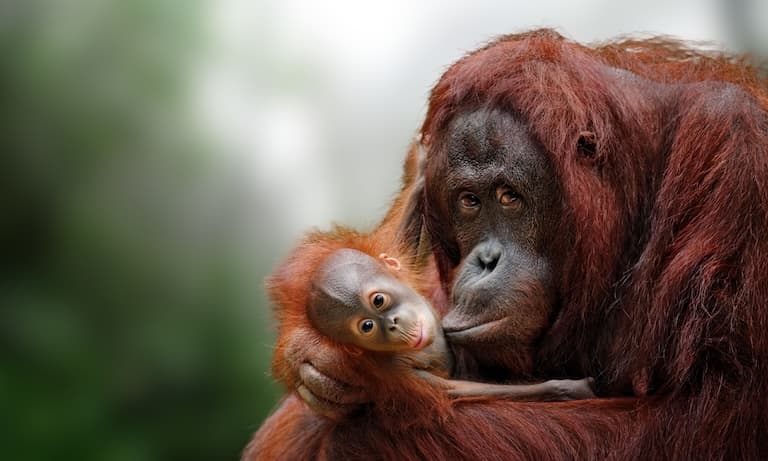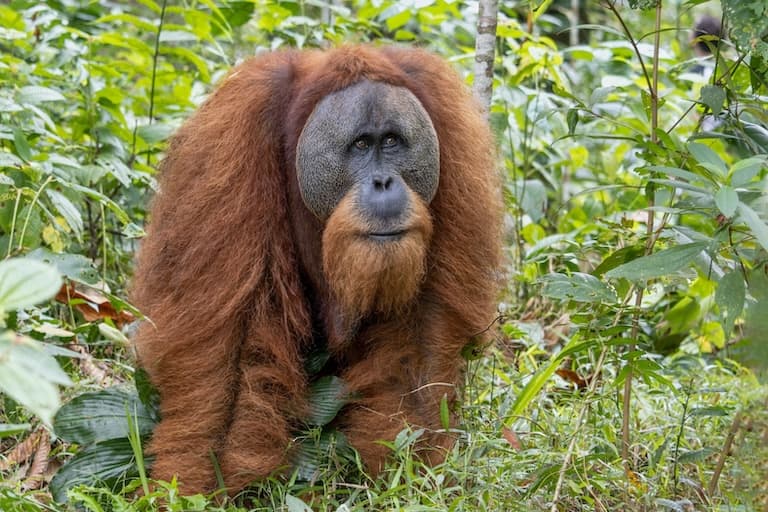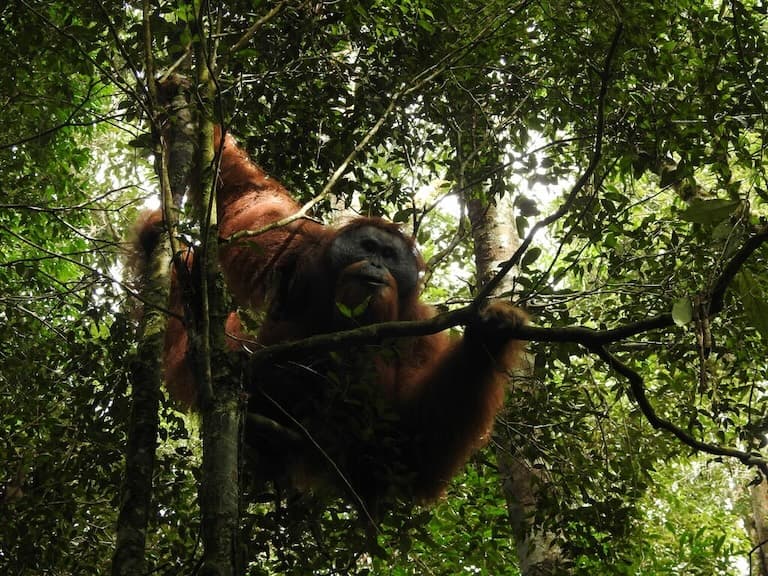Tapanuli Orangutan Profile
Around 74,000 years ago, a volcanic eruption occurred in Southeast Asia that was so enormous, it appears to have impacted primate species all the way over in Africa. Gorillas and chimpanzees – not to mention a host of other non-primate species – saw a significant decrease in population, even as far as 10,000km from the volcano.
So, it’s no wonder that the local primate species suffered, too. Today’s Orangutans all expanded from a population bottleneck caused by this eruption, and now inhabit landmasses literally built from the acidic, igneous rock spewed from the Toba crater. Remarkably, the largest arboreal animals in the world are still so poorly understood that it was only in 2017 that researchers identified the Tapanuli Orangutan as a new species.

Tapanuli Orangutan Facts Overview
| Habitat: | Arboreal, tropical rainforest |
| Location: | Sumatra |
| Lifespan: | 30+ years |
| Size: | 1.6 metres (5ft 5) |
| Weight: | Around 70 kg in large males (154 lb) |
| Colour: | Light orange/brown |
| Diet: | Leaves, insects, pine cones |
| Predators: | Tigers, humans |
| Top Speed: | Unknown |
| No. of Species: | 1 |
| Conservation Status: | Critically Endangered |
The Tapanuli Orangutan is exceptional for a number of reasons, some better than others. Here is the most recent species of great ape discovered, both as a population in the ‘90s and as a species in 2017. It immediately then became the most endangered species of ape in the world, and to this day, the most neglected, having experienced very little progress in the conservation world, and a lot more destruction and partitioning of its dwindling habitat. Of all the “Last Chance to See” species on your list, this one should be near the top.
Interesting Tapanuli Orangutan Facts
1. They’re one of us
Back in the day, the part of Asia we now associate with orangutans was home to various great ape species. There were Denisovians, possibly Neanderthals too, maybe even the mystery yeti Gigantopithecus, and a genus known as Sivapithecus, or the ancestral orangutans. All of these species are hominids, though separated by varying millennia of genetic isolation.
But some hundreds of thousands of years ago, they may well have all shared a habitat. And it would be Sivapithecus that crossed into what is now Indonesia from mainland Asia around 3.4 million years ago to become the Bornean orangutans, who would then expand into the island, leaving behind the Tapanuli Orangutan, who would eventually become its own species.
This isolation would be compounded by the eruption that exploded much of Sumatra and created the stunning Lake Toba, around 74,000 years ago.
Most of the species involved in the history of great apes are now extinct, but the Tapanuli orangutan endures, as the eighth species of great ape left in the world. And while Apes together, strong, our species is a bit slow to start pulling its weight in the group.

2. They were discovered in 2017
Indonesia looks deceptively small on the map. What appears to be a smattering of tiny islands actually comprises the 14th largest country in the world, and therefore, understandably, the largest nation archipelago. It’s half the size of India and twice the size of Thailand. So, it’s a big place, and this explains how, even with the rampant deforestation the country is experiencing, there are still many lost mysteries to be discovered in it.
One such mystery recently discovered was this orangutan itself – but to be clear, the population wasn’t entirely new to science, only its phylogenetic position. It was, however, only discovered for the first time in 1997, before which there were no known orangutans south of Toba. But in 2017, this small population of what was originally thought to be a subspecies of the only orangutan species known to science at the time.
But today, it’s one of three accepted species, the other two being the Sumatran and the Sundaland species (That’s Sundaland, the geographic region that once connected Asia to Australia, not Sunderland, the cold and desolate location of the world’s oldest machine-made rope factory in the North of England).
And immediately on identifying this group as a new species, they have become unique1.

3. They’re cooler
Some of the traits that distinguish this species from its local cousins are visible on its face. The Tapanuli orangutan has a wider face, in the flanged males, at least, and a more distinctive moustache.
But other differences are ecological. This species occupies higher altitudes and cooler temperatures than the Sumatran orangutan can endure, and chooses habitats with more rainfall, too.
As well as this, they eat different food, with quirky little supplements like caterpillars and pine cones, and, unlike other species, they rarely, if ever, come down from the trees.
4. They’re up there for a reason
The largest arboreal animal isn’t restricted to the canopy out of pure desire or some kind of individual biology, and on some islands in Indonesia, orangutans return to the ground often.
But this species in particular has never been seen on the ground at all, and it’s thought the reason for this is the enormous Pleistocene predator that lurks about on the forest floor.
Sumatran tigers still roam the forests of their native island, and, as giant felids have always done, they still hunt hominids. Just as leopards would have kept our own ancestors in trees for unknown millennia, these tigers put the right willies up our orangutan cousins, and we find that in areas where the scary cats are, the apes choose not the wander about.

5. Their habitats are breaking up
Looking at Lake Toba from the map, it barely makes a scuff on the largest island in Indonesia. Sumatra is truly an enormous place, and it’s hard to imagine that little old us could make a dent in a habitat that large, but we are nothing if not tenacious, and in the region of the Tapanuli Orangutan, where there once were swathes of uninterrupted, pristine, lowland forest to swing about in, there is now a single point of refuge, the Batang Toru forest, where this species can be found.
And even within this forest, the viable real estate has been chopped up and interrupted.
Habitat fragmentation is the silent killer of species. Everyone knows if you destroy an animal’s habitat, you can expect to lose it, but lesser-known to the majority of people is the effect of breaking up that habitat. While, from space, the green seems unending, down on the ground, this incredible mass of trees is separated into clusters by human development. And the animals within it, unable to cross these boundaries, get separated into pockets of low genetic diversity, gradually becoming less healthy over generations as a result.
Within the Batang Toru, the Tapanuli orangutan is broken into three separated blocks, at least two of which are so separated that they can no longer mingle at all. 95% of their previous range is gone, and their numbers are rapidly dwindling.
6. They’re Critically Endangered
It’s thought that there are between 250 and 1000 individuals of this species left, and these numbers are frightfully out of date. The prognosis is not looking good for the most recent of the great ape species to be discovered.
Because of this, the IUCN has them pegged as Critically Endangered, and the threats to the species are not likely to abate any time soon2.
The latest assessment was all the way back in 2017, and since then, a huge hydroelectric plant has been built in prime orangutan territory; illegal logging persists, and the rarest of the great apes may already be too far gone to recover.
Tapanuli Orangutan Fact-File Summary
Scientific Classification
| Kingdom: | Animalia |
| Phylum: | Chordata |
| Class: | Mammalia |
| Order: | Primates |
| Family: | Hominidae |
| Genus: | Pongo |
| Species Name: | tapanuliensis |
Fact Sources & References
- Nater et al (2017), “Morphometric, Behavioral, and Genomic Evidence for a New Orangutan Species”, Current Biology.
- Nowak et al (2024), “Tapanuli Orangutan”, The IUCN Red List of Threatened Species.
